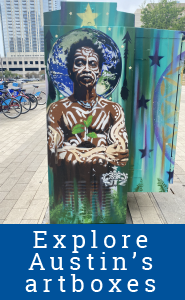Emerging Mobility Technology involves deploying new technology to move people and goods through the city in faster, safer, cleaner, more affordable and more equitable ways.
Emerging Mobility Technology seeks to foster creative mutually beneficial partnerships to support the safe development, testing, and integration of emerging mobility solutions into Austin’s transportation network. This testing offers a preview of the technology that may soon arrive on Austin streets, and in this way, the Smart Mobility office helps prepare Austin Transportation to manage the emerging technology that is on the horizon.
Private sector organizations wishing to propose smart mobility projects not listed as calls for partnerships should submit a Public-Private Partnership Opportunity Expression of Interest Form.
- Pilot Program

TAPCO
TAPCO recently deployed technology in Austin to test their Connected Vehicle Pedestrian Crosswalk Warning System. This pilot will test the system's ability to improve pedestrian safety by informing drivers when they are approaching pedestrians who are crossing the street.
When the crosswalk’s push-button is activated, the system will send communications to nearby connected vehicles that pedestrians are present and crossing the street in their intended path. Connected vehicles can use this wireless technology to communicate with infrastructure and other vehicles, and their features include displaying basic safety messages to drivers.
The system also provides warnings to drivers of non-connected vehicles using highly visible, rectangular rapid-flashing beacons on both sides of the road. This pilot will also help the City develop a process for retrofitting older infrastructure with the new connected vehicle technology. TAPCO Pilot
VELODYNE
The Smart Mobility Office is piloting with Velodyne Lidar to analyze road safety and mobility through the collection of real-time traffic data. An AI-powered software solution is combined with a laser sensor or LiDAR to monitor road networks, and generate real-time traffic data such as near-miss incidents and Advanced Traffic Signal Performance Metrics and Safety Analytics (ATSPM). Unlike many camera-based solutions, LiDAR works in any weather or lighting conditions and creates a real-time 3D perception for all types of road users with a single sensor at the corner of intersections. Velodyne Pilot
NTT-SMART CITY PLATFORMS
The Smart Mobility Office is piloting NTT's Smart City Platform which has the potential to digitally transform traffic management operations through the real-time detection and notification of specific traffic conditions. The deployments will be evaluated for their capability to bring better situational awareness at selected locations by collecting, analyzing and reporting of various transportation situations such as wrong-way driving incidents as well as vehicle counts, volumes and trends. Automating the production of data analytics through event or rule based algorithms can be a highly cost-effective means to augment personnel by directing their attention to key events and quickly aggregating raw data for further analysis.
.jpg)
- Street Banners
-
 The Street Banner program provides a service to community nonprofits, arts and cultural groups, and other organizations that need an effective tool to promote events and public information of interest and benefit to Austinites and visitors.
The Street Banner program provides a service to community nonprofits, arts and cultural groups, and other organizations that need an effective tool to promote events and public information of interest and benefit to Austinites and visitors. - Connected and Autonomous Vehicles
-
State laws regulate the operation of connected and autonomous vehicles. The City works with public safety agencies and state partners to identify issues and work on resolutions with the private operators.

